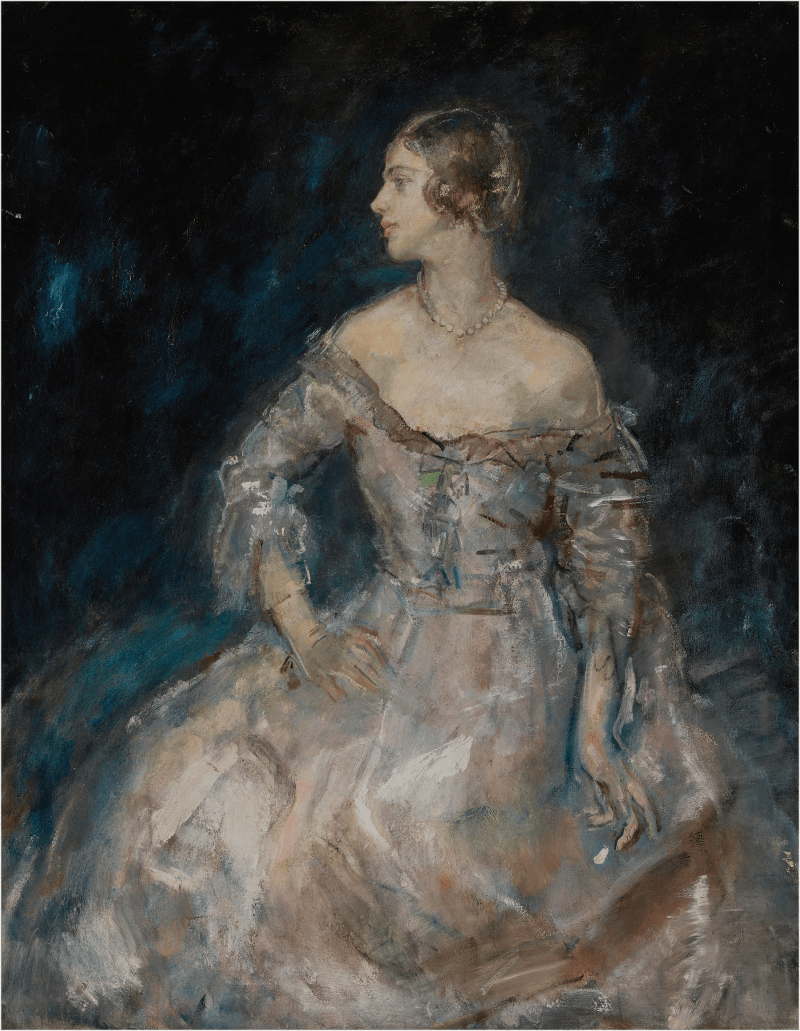Ambrose McEvoy, who’s short life and career has until recently been overlooked, was one of the most successful society portrait painters of his day. The present work is a rare example of his early experimentation in landscape painting.
McEvoy was first drawn to the genre of landscapes in 1903 when he and his wife Mary stayed in a cottage on the country estate of the notable art patron Sir Cyril Kendall Butler. The influence of modern mavericks such as J. M. W. Turner and James Abbott McNeill Whistler are palpable in his landscapes, and the present work is no exception. A tall tree with a sweeping canopy dominates the foreground of the composition, executed in swift and free brushstrokes. In the middle distance, deft stokes of paint suggest the outline of a figure, strolling across a path. It is this rejection of more rigid realism which distinguishes McEvoy’s working method from many of his elders, offering a more poetic and...
Ambrose McEvoy, who’s short life and career has until recently been overlooked, was one of the most successful society portrait painters of his day. The present work is a rare example of his early experimentation in landscape painting.
McEvoy was first drawn to the genre of landscapes in 1903 when he and his wife Mary stayed in a cottage on the country estate of the notable art patron Sir Cyril Kendall Butler. The influence of modern mavericks such as J. M. W. Turner and James Abbott McNeill Whistler are palpable in his landscapes, and the present work is no exception. A tall tree with a sweeping canopy dominates the foreground of the composition, executed in swift and free brushstrokes. In the middle distance, deft stokes of paint suggest the outline of a figure, strolling across a path. It is this rejection of more rigid realism which distinguishes McEvoy’s working method from many of his elders, offering a more poetic and increasingly modernist vision of his subject.[1] Throughout his life, McEvoy’s friends and family encouraged him to paint more landscape views, although the demands of his patrons left little time to do this.
McEvoy exceptional artistic abilities were evident from a young age. He was inspired by Whistler, who was a great friend of his father, Captain Charles Ambrose McEvoy, and enrolled at the Slade School of Fine Art at the age of sixteen. He studied at the Slade between 1893 and 1898 and afterwards rented a small flat in Danvers Street, Chelsea, where he lived and worked. He soon established himself as a gifted genre painter; he explored rolling landscapes and intimate interior scenes whilst attracting attention from wealthy patrons and collectors. It was during the mid-1910s that McEvoy ventured increasingly towards portraiture and the demand for his portraits rose concurrently. He became well known for his innovative style and florid methods which endeared an emerging generation of young, wealthy and liberal-minded patrons. His paintings became sought after and he maintained an illustrious list of clients spread between the United Kingdom and America, where he was represented for a period by the most celebrated international art dealer of the day, Lord Duveen.[2]
However, this youthful success was to take its toll on McEvoy and he died in 1927, aged forty-nine. Critics writing shortly after his death were in little doubt as to the significance of his work; ‘the most refined aspect of early twentieth century society will live on in his work, and that alone ensures his position in history’.[3]
[1] Akers-Douglas, E. A., Hendra, L. (ed.), (2019) Divine People: The Art & Life of Ambrose McEvoy. London: Paul Holberton Publishing, p. 65.
[2] Akers-Douglas, E. A., Hendra, L. (ed.), (2019) Divine People: The Art & Life of Ambrose McEvoy. London: Paul Holberton Publishing, p. 176.
[3] (1928) 'Ambrose McEvoy', Country Life. 28 January, Vol. 13, No. 1619, p. 106.

